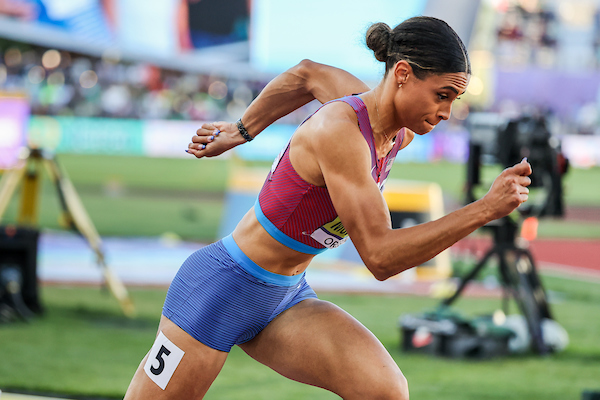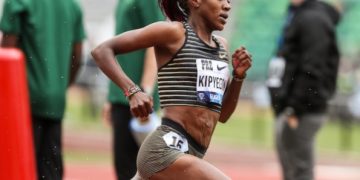This was how long-time track & field scribe Elliott Denman wrote about those amazing ten days in July 2022, in Eugene, Oregon.
IT ONLY TOOK 39 YEARS
BUT EUGENE BROUGHT
SUPERB WORLD MEET
TO USA FOR THE FIRST TIME
By ELLIOTT DENMAN
EUGENE, OREGON – Well, it only took 39 years…
But the United States – at last, at last – played its proper role as a global leader in the most classic of all sports by opening its own doors and facilities to the biggest event there is, apart from the Olympic Games.
The World Championships of Track and Field – which concluded a successful 10-day run at the magnificent Hayward Field, and some nearby road racing venues on 24 July 2022, was a heck of an event, and if you hadn’t been a track and field fan beforehand, and managed to score a ticket or two, you surely would have been an enthusiast by the time you headed home.
Lots of amazing athletes, representing 179 nations, as well as a refugee athlete team, taking on the greatest challenges the sport has to offer in the direction of running, throwing, jumping, and walking, making it a sensational event, a heck of a good thing, in all directions.
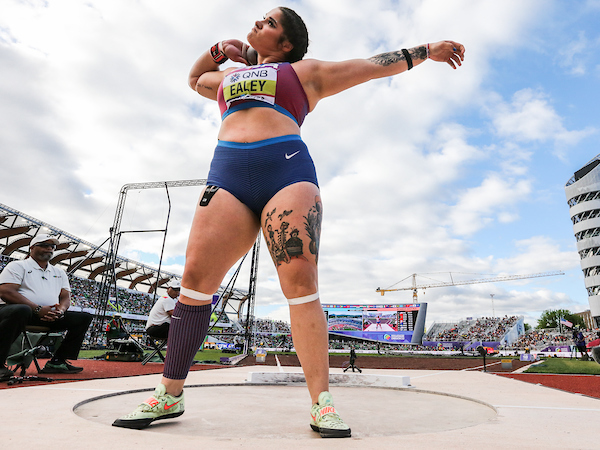
Eugene, Oregon, USA
July 15-24, 2022
shot put, gold medal, photo by Kevin Morris
It started with really great stuff for the home fans – that 1-2-3 USA medal sweeps in the men’s 100 and shot put. But soon, the counter-attacks were underway.
Those Jamaica ladies were incredible – as ever. No wonder so many of their fans who’d found their way to Oregon were adorned in those “Faster Forever” t-shirts.
Soon, day by day, the rest of the world began finding its groove.
Jake beat Jakob – Wightman beat Ingebrigtsen – in a brilliant 1500 meters as British fans exulted. And Jake’s father – Geoff, was the stadium announcer! But Norway’s Jakob would come right back to win the 5,000 meters.
Distance runners from East Africa were again amazing Bun no longer were these events a Kenya-Ethiopia dual meet. Uganda’s a major distance power now, too. And did you notice how USA’s Grant Fisher was in the middle ot it all? And those steeplers from Morocco and Kazakhstan striking gold, too?
Stiil, no world records until Day Eight. It took a Jersey Girl – Sydney McLaughlin, the pride of Dunellen, the Union Catholic High School Alumni Association, and now the pride of her whole nation, and probably far beyond, to achieve all this in just 50.68 seconds. Count on younger ladies of the universe to start telling their moms and dads – “when I grow up, I want to be a Sydney, too.”
Dunellen Syd is so good at the 400-meter hurdles – get this – that she’d have been beating almost all others over the one-lap distance – even without those pesky 10 hurdles in their lanes.
And thus, World Athletics president Seb Coe, at last,/at last got to present the giant-sized $100,000 check to all who got those two big letters – WR – flashed with their name on the giant scoreboard.
Seb got to trot out those big 100-grand WR checks twice more as the meet raced to its Sunday night conclusion.
First, Tobi Amusan of Nigeria sprinted over the women’s 100-meter hurdles in 12.12 seconds. And this was just the semifinal. WR again.up on the board. She was even faster in the final – 12.06 – but just slightly wind-aided. Take note: Amusan is a fomer Texas-El Paso athlete. Like so many others from so many nations here at Worlds, she’s benefited hugely from the superb and giving U.S. college system.
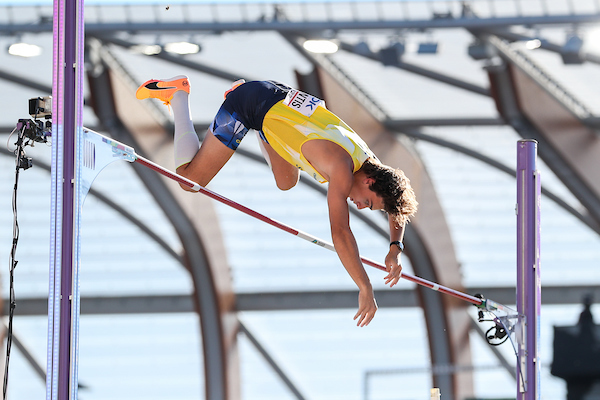
Eugene, Oregon, USA
July 15-24, 2022, photo by Kevin Morris
Just moments after the last 4×400 relay team had crossed the line – in an event Syd anchored the USA to gold in a brilliant 47.91 lap – Armand “Mondo” Duplantis of Sweden (and Lafayette, Louisiana) soared up-up-up and over the pole vault bar raised to 6.21 meters, or 20 feet, 4 1/2 inches, as the crowd went wild – for the final time. Mondo has now cleared 6 meters more often than the great Sergei Bubka of Ukraine. He is so good at his catapulting specialty that he’s now more than one-third of the way to 21 feet. Is anything like that even humanly possible in this evolving event? Answer: never say never.
There was something in this World Championships for everyone. Of those 179 nations, 29 had gold medalists, and 81 had finalists.
There was all-new Worlds glory at this level for Peru, Kazakhstan, and Nigeria. It was 20K/35K racewalker Kimberly Garcia Leon of Peru who racewalked to double individual gold, a feat no other athlete here achieved.
TV viewership ratings were high and strong. Global watchers got to see a darn good show.
The World Championships, of course, were born in Helsinki in 1983 – as an alternate to the Olympic Games, to give the world’s elite more than one chance in four years to sparkle on their sport’s biggest stage. The next 16 editions were held in Rome, Tokyo, Stuttgart, Goteborg, Athens, Seville, Edmonton, Paris, Helsinki (again), Osaka, Berlin, Daegu, Moscow, Beijing, London, and Doha. And then it was Eugene’s – and USA’s – time in the sun.
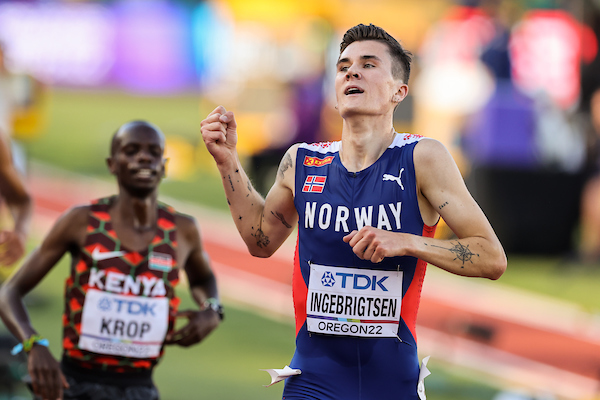
Eugene, Oregon, USA
July 15-24, 2022, photo by Kevin Morris
Needless to say, there were ups and downs attached to all of them – and that statement comes from first-hand knowledge; I have been told that I’m now the lone American media person to be credentialed to all of them.
That so, let me take this opportunity to say a few things,
Know what? Eugene could have been even better.
Here’s a short list of things that shoulda-coulda-woulda have made it more of a great global event than it was:.
The big one here: They should have imposed a fans’ no-bankruptcy policy from Day One – in other words, no sticker shock at reading the grossly inflated price tags put on everything from stadium tickets to accommodations to car rentals and parking spots.
The 10-day program was too long. It could have been done in seven or eight. If all the Oregon state travel bureaus were really intent on getting visitors to check out their delights, visitors should have been allowed a day off – or two or three – to get that done. A free Tuesday or Wednesday or Thursday to do some exploration would have been excellent,
Eugene establishments should have been more cooperative, too. Instead of doing it the old-old pre-Worlds way – closing up shop around 10 p.m – they should have noticed that the multitudes weren’t leaving Hayward Field en masse – after all the medal ceremonies were done, etc. – until about 8.30 or 9.
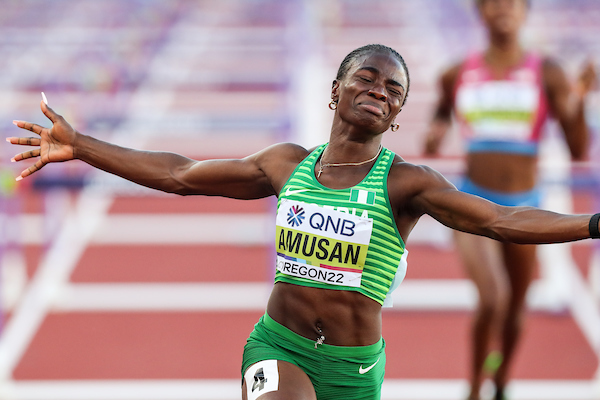
Eugene, Oregon, USA
July 15-24 2022, photo by Kevin Morris
With all this, it was no wonder that so many vacant green seats were seen at Hayward – especially so in the early days of the meet.
Lots of solutions were offered. Seems like few were accepted. Offer kids – boy scouts, girl scouts, young track folk, young athletes of any kind – free tickets. Why not? And thus build a fan base for the future.
Kindlier treatment for the foot soldiers of the event, that army of purple-shirted volunteers that made so much possible for so many others. Give them tickets for their off-days? No, keep them in relative solitary confinement in the course of their duties – don’t want these folks actually communicating with the athletes. It’s that legendary Oregon volunteer army that helped Eugene get the Worlds bid in the early stages.
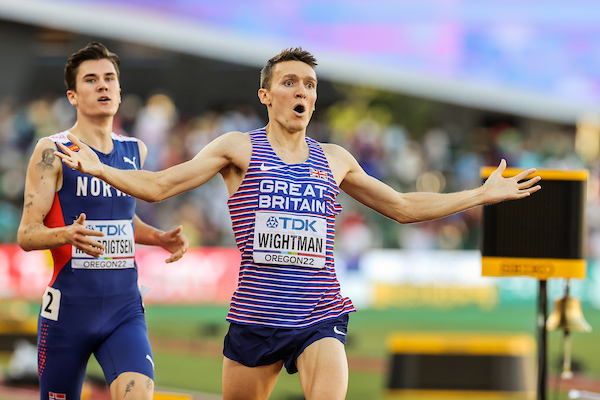
Eugene, Oregon, USA
July 15-24, 2022
1500 meter final, Wightman, GBR, New Balance, photo by Kevin Morris
Oh….and they could have built a kinder, gentler Hayward Field for some older folks in the first place. It’s said to have just a single – and tiny – elevator to the big upper deck.. Climbing, and schlepping up all those steps, was a big chore for most who weren’t training for the Eugene marathon.
OK, and no more negativity. Good on you, Eugene, a place where every resident is on a first-name basis.
Bottom line: you did it when no other USA city had even tried.
Author

One of the finest and most prolific writers in our sport, Elliott Denman has written about our sport since 1956, when he represented the US in 1956 Olympic Games at the 50k race walk, the longest event on the Olympic schedule. A close observer of the sport, Elliott writes about all of our sport, combining the skills of a well honed writer with the style of ee Cummings. We are quite fortunate to have Elliott Denman as a friend and advisor.
View all posts

